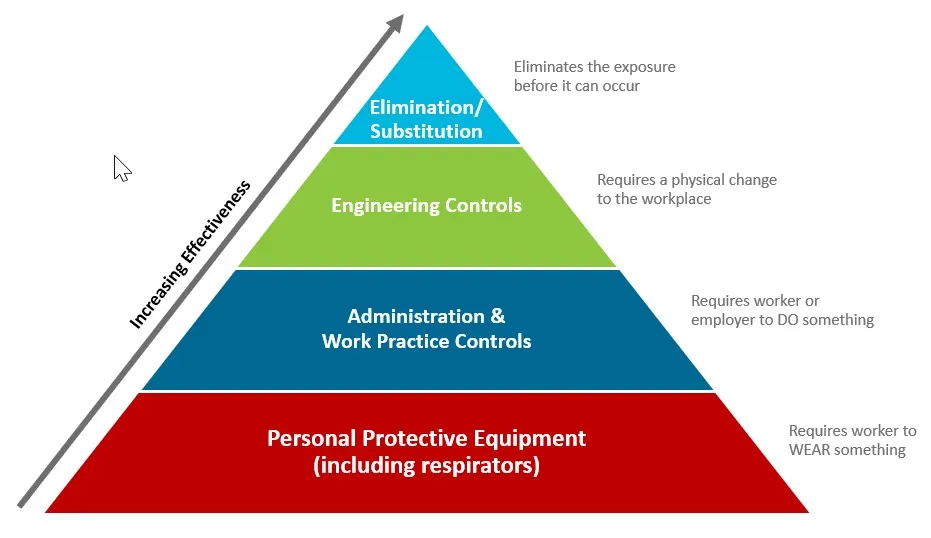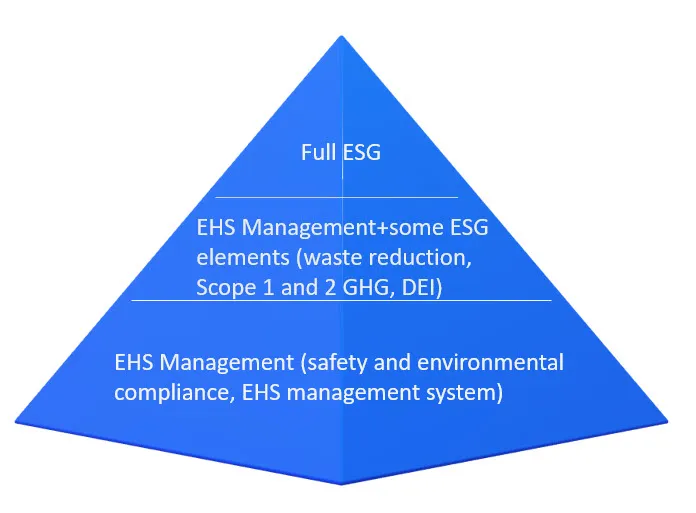Welcome to the second and final installment of our two-part series “An Overview of ISO 14001.” In our first installment, we talked about what an environmental management system is (and isn’t) and how ISO 14001 can help you determine the key environmental aspects of your business.
In what follows, we’ll break down some of the key aspects of ISO 14001 and explain how they can help EHS professionals maintain compliance with environmental regulations, and advance toward greater ESG maturity.
Environmental Compliance
The first installment of this series talked about the process of assessing the environmental impacts of an organization. The next step is to evaluate a company’s compliance with applicable environmental regulations. For example, managers of a facility that emits regulated air contaminants, such as hazardous air pollutants (HAPs) and volatile organic compounds (VOCs), would need to determine whether the amounts emitted trigger air emissions permitting, and specifically, which type of air emissions permit. This is a crucial determination, because facilities that are subject to Major Source/Title V permitting requirements will have much more significant compliance obligations.
Section 6.1.3 states that organizations need to not only determine their compliance obligations, but also account for those obligations when “establishing, implementing, maintaining and continually improving its environmental management system.” A note to the text in 6.1.3 correctly observes that compliance obligations can result in both risks and opportunities. We can easily understand that point by observing how compliance obligations play out in the real world. Companies that fail to meet their regulatory requirements can find themselves dealing with fines, and depending on the size of the fines and the reasons for them (e.g., a major chemical release), those can also create huge reputational risks. On the other hand, a company that ably navigates the regulatory landscape and even goes beyond its compliance requirements will have a competitive advantage.
One of the challenges here is that the regulatory landscape keeps changing. For example, you’re probably aware of the increased public concern regarding polyfluoroalkyl substances (PFAs), commonly dubbed “forever chemicals” because of their long persistence in the environment. Many companies historically used PFAs in common commercial and manufacturing applications, such as a component in the coating for non-stick frying pans, water-repellant fabrics, fire-fighting foams, and packaging for common food products.
Growing concerns about PFA contamination of soils and water sources and their effects on human health have led EPA to take additional regulatory actions on PFAs. One of the most far-reaching has been use of the National Defense Authorization Act (NDAA) to add 175 individual PFAs to date to the list of Toxic Release Inventory (TRI) reportable chemicals, with more PFAs to be added over time. Most TRI (aka “Form R”) listed chemicals trigger reporting at 10,000 pounds (if otherwise used) or 25,000 pounds (if manufactured or processed), but the listed PFAs require reporting at a threshold of only 100 pounds, whether manufactured, processed or otherwise used. This means that within a relatively short period of time, companies using PFAs have needed to identify, quantify and track the movement of TRI-listed PFAs in their inventory, or risk being out of regulatory compliance, and potentially exposed to fines.
Companies need to ensure they not only have a way to track their regulatory obligations as they are today, but also to keep up as the regulatory landscape evolves. The right environmental compliance software can provide a major advantage there.
ISO 14001 on Objectives
One way many companies traditionally approach managing their objectives is through using a strategy of setting “objectives, targets, and programs.” Let’s take a closer look at how this works and how it can help.
Objectives are goals, stated generally, that you would like to meet in the future. In other words, when you’re writing an objective, even though you should already be thinking about how you’re going to measure and verify them, you’re not going to get that granular yet.
Targets are the point where granularity comes in. Setting targets involves determining specific verifiable measures to document that you’re meeting your objectives and meeting the chosen performance criteria.
Programs are the specific methods and strategies you’re going to use within your environmental management system to achieve your objectives and targets.
We can see an example of what actual Objectives, Targets and Programs might look like in the table below.
| Objective | Target | Program |
| Reduce facility’s electrical energy consumption. | Reduce facility’s electrical energy consumption by 10% relative to fiscal year 2020 baseline. | Replace incandescent bulbs in main factory with high-efficiency bulbs. |
Note that the above is a simplified example, and you can have multiple programs to meet an objective and achieve a target.
Support Needed for Environmental Programs
Resources
ISO 14001 wisely recognizes that even the best-conceived management initiatives won’t be more than aspirational without the right resources. These resources include the financial budget, as well as equipment, facility infrastructure, and technological tools necessary to improve environmental management.
The specific resources needed will depend on your organization and its operations, and on your Aspects and Impacts analysis. For example, you may find that a secondary containment structure is warranted for storage of hazardous chemicals to reduce potential for a spill to impact soil or stormwater pathways, or continuous emissions monitoring and alarm systems are needed to identify anomalous spikes in emissions. Or, you may determine that software is needed to share responsibility for key tasks with front-line workers, or provide better access to data to share progress toward environmental objectives and boost engagement.
Awareness
That last point is a nice segue to talking about the importance of awareness.
In my past lives as a consultant and as a Global EHS Coordinator, I’ve been to facilities that had reasonably well-thought-out environmental policy manuals, but according to site EHS reps, were not seeing the kind of progress they wanted toward their environmental goals. One of the major reasons for this would become apparent to me when we went on the site walk-through. Although my site representative had spoken confidently and glowingly about environmental programs such as recycling and waste reduction programs in the facility, the employees I spoke to had no idea such programs existed.
This can hurt environmental performance related to regulatory compliance and progress toward objectives in significant ways. The most direct impact is that because these programs depend upon employee participation to be successful (e.g., knowing how to separate landfill waste from recyclables), they’re not going to succeed if employees don’t understand their own roles. Indirectly, but still significantly, a lack of awareness about your environmental programs and the progress they’ve made to date can adversely affect the motivation of employees at all levels to support your efforts, whether they know their own roles or not.
Section 7.3 spells out expectations for awareness. It specifically states that the organization must ensure that “persons working under the organization’s control” (which includes regular payroll employees as well as temporary and contracted workers) know the organization’s environmental policy, the significant environmental aspects and impacts of their work, and their role in contributing to the success of the environmental program. Per the Standard, they should also understand the consequences for the company of failure, including the potential for findings of noncompliance and associated fines.
Environmental Management and Operations
Operational Planning and Control
Earlier, we discussed the importance of reviewing all of your company’s operations for environmental aspects and impacts. Like any risk assessment, your Aspects and Impacts analysis is only productive if it results in your identifying and implementing effective controls within those same operations. To put it simply, the purpose of identifying risks is to control risks.
Section 8.1 of ISO 14001 states that management must establish “operating criteria” for its processes, and implement controls for those processes. A note to this section states that “controls can include engineering controls and procedures” and “can be implemented following a hierarchy (e.g. elimination, substitution, administrative) and can be used individually or in combination.” The specific idea referenced here is that of the hierarchy of controls, as shown in the image below.

The categories of controls are arranged in the form of a pyramid, with the most effective controls at the top and the least effective on the bottom. Removing hazards that create risks is always the best option when possible, because nothing further need happen. Personal protective equipment (PPE) is the least effective method for good reason – a number of factors need to align for the PPE to be effective. There needs to be proper selection, effective training, sufficient employee understanding of that training, and maintenance of the PPE if it is going to be reduce exposures to acceptable levels.
Section 8.1 also states that management must “control planned changes and review the consequences of unintended changes,” which is essentially what an MOC procedure is about. As mentioned earlier, MOC needs to be integrated with your environmental management system to ensure that you’re identifying and controlling risks from planned changes before those changes go live.
The larger and more complex your operation is, the more difficult it may be to effectively manage all workflows for all future changes. Luckily, modern MOC software can help here by facilitating creation of workflows, approval of key steps, and documentation of all actions taken.
Emergency Preparedness and Response
Section 8.2 of ISO 14001 states that organizations need to establish, implement, and maintain processes to respond to emergency situations. The organization’s emergency planning needs to include testing of planned responses, examples of which include fire and other emergency evacuation drills, and testing of any equipment involved in emergency response, such as fire alarms and portable communication devices.
ISO 14001 also indicates that organizations must provide relevant information and training to employees and “as appropriate, to other interested parties, including persons working under its control.” The meaning of that last part may vary depending on the organization and its specific aspects and impacts, but two groups you shouldn’t forget are contractors and visitors. These two groups are likely to be the least familiar with a facility’s operations and emergency procedures, yet often receive little or no attention from the organization’s emergency plans.
To remove all doubt that the phrase “persons working under its control” includes contractors, ISO 14001 Appendix A.3 (“Clarification of Concepts”) states “The phrase ‘external provider’ means an external supplier organization (including a contractor).” Section 8.1 also states that the organization should “communicate its relevant environmental requirement(s) to external providers, including contractors.” That means you’ll need better visibility and control of contractor management, with ability to confirm qualifications and training for contractors before they ever arrive on site.
Environmental Performance Evaluation
You can’t manage your environmental program effectively unless you’re measuring your performance. But you also can’t accurately measure your performance unless you’ve selected and tracked the metrics that are relevant to your organization and its goals.
That means that your choice of metrics needs to be closely tied to your analysis of your internal and external context and Aspects and Impacts (as discussed in our first installment) and your compliance obligations, and should be directly connected to your Objectives, Targets and Programs.
Here are some examples of key performance indicators (KPIs) you may want to track, depending on their materiality to your organization:
- Waste: waste generated annually (tons), hazardous waste generated annually (tons), waste sent to landfill annually (tons), and trends in these metrics (e.g., % reduction in hazardous waste generation)
- Air emissions: tons of various air contaminants emitted annually (e.g., VOCs, HAPs) and directional trends year over year, number of permit noncompliance findings
- Wastewater discharges: volume of industrial wastewater discharged annually (gallons), amounts of various contaminants such as fats, oils and grease (FOG) and total suspended solids (TSS) in annual discharge, number of discharge permit noncompliance findings
- Stormwater discharges: Number of inspections that identified issues with stormwater best management practices (BMPs), number of stormwater permit noncompliance findings
- Energy consumption: Total annual energy consumption (kWh), annual energy consumption by fuel source (e.g., natural gas, electricity, propane), % of annual energy from renewable sources, directional trends in energy consumption (e.g. % reduction in energy)
- GHGs: Annual overall GHG emissions, plus itemized totals for Scope 1, Scope 2, and Scope 3 GHGs, and directional trends in GHG emissions (e.g. % reduction in overall GHG emissions or in specific scope emissions)
EHS to ESG: Starting the Journey
The great thing about ISO 14001 is that it models a management system that grows with your management maturity level.
If your biggest priority today is just trying to get a better handle on your environmental compliance responsibilities, ISO 14001 can give you the framework you need. It gives you important guidance about identifying your environmental aspects, impacts and legal requirements, as well as guidance on taking a more integrated view of your organization and its operating context, which you need to keep up with your compliance obligations, even as the regulatory landscape continues to evolve.
On the other hand, if you’re ready to start taking on some ESG and sustainability initiatives, ISO 14001 can help there, too. A good Aspects and Impacts analysis will provide insight into which operations have environmental significance, such as energy consumption, water discharges or waste generation. From there, you can set up Objectives, Targets and Programs for specific environmental goals, such as energy reduction and GHG reduction, and choose metrics to track progress toward those goals.
Even as you reach a higher level of ESG maturity, ISO 14001 can still be an important part of your journey. Successful ESG management depends on having a solid foundation of EHS management, as the ESG pyramid below shows.

ISO 14001 gives you a framework for an environmental management system that includes all levels of the ESG pyramid. For example, when you’re ready to do so, you can use other environmental ISO standards like ISO 14064 for GHG measurement and reporting in conjunction with 14001 to reflect the widening scope of your environmental and ESG programs. Having a continuous management program means that you’ll have no gaps in your ESG pyramid, and you’ll be not only better able to achieve ESG maturity, but also to maintain it.
In short, ISO 14001 can be your guide on the journey from EHS to ESG, and all points in between.
Let VelocityEHS Help!
Our Environmental Compliance solution, part of our VelocityEHS Accelerate® Platform, can give you the visibility and control to improve all facets of environmental management. We can help you manage your air emissions, water discharges and wastes, with ability to access your most important data in one place and streamline key regulatory reporting responsibilities.
We can also help you gain the visibility you need to manage contractors with our Control of Work solution. You’ll be able to easily ensure that no third-party contractors arrive on-site without proper credentials and training.
As always, please feel free to contact us to learn more about how we can you reach your environmental and ESG goals.
